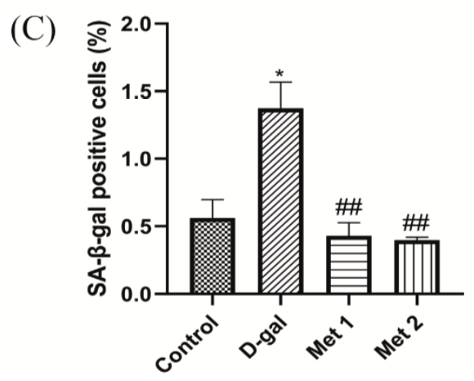Key Points:
- The diabetes drug metformin preserves thymus structure and boosts the function of thymus mitochondria (cell powerhouses).
- Treated mice exhibit fewer senescent cells — growth-arrested cells associated with promoting aging — than untreated aging mice.
- Treatment with metformin increases the activity of multiple essential proteins responsible for proper functioning of the thymus.
As we age our organs naturally deteriorate, leaving our dwindling bodies more susceptible to a myriad of age-related diseases and damage from foreign invaders. One particular organ that degenerates with age and negatively affects the immune system upon impairment is the thymus. Given that a healthy thymus is essential for proper functioning of our immune system, scientists have heavily focused on identifying therapeutics that can delay thymus aging.
In a new study published in International Immunopharmacology, Yang and colleagues from Zhengzhou University successfully combated thymus degeneration in an aging-mouse model with the well known diabetic drug metformin. Here, investigators showed that metformin preserves thymus mitochondrial function by restoring the mitochondrial membrane potential – the electrical gradient needed for the production of cellular energy (ATP) – and eliminating compounds that induce oxidative stress – reactive oxygen species (ROS). What’s more, they found that metformin treatment reduces that amount of thymus senescent cells, zombie-like cells in permanent state of cell cycle arrest. Notably, metformin increased the activity of critical thymus proteins (FOX1, Aire, SOX2), indicating a protective effect on thymic function.
Metformin Preserves Thymus Structure and Boosts Mitochondrial Function
Healthy functioning mitochondria are the pillars of sustained cellular function. Inevitably, aging leads to dysfunctional mitochondria, capable of triggering chronic low-grade inflammation that can lead to DNA and cell structure damage. With this in mind, Yang and colleagues tested if metformin could sustain thymic structure and boost mitochondrial function to ultimately preserve thymic function. To induce accelerated aging of the thymus, investigators supplemented two-month old mice with a sugar called D-galactose for eight weeks. Then, mice were treated with metformin (100 or 300 mg/kg/day) for 6 weeks to monitor the structural changes of the thymus. Compared to untreated mice with altered thymus structures, results showed that metformin restored the thymus structure of both treated groups, indicating that metformin helps preserve thymus morphology upon aging.
Yang and colleagues proceeded to monitor mitochondrial membrane potential and the presence of ROS. The findings showed that untreated mice displayed significantly lower membrane potentials while treated mice had membrane potentials similar to those seen in untreated control mice. However, mice that received 100 mg/kg metformin had the highest membrane potentials, suggesting that this dosage may be less toxic than 300 mg/kg metformin and more suitable for cellular uptake. Following ROS quantification, results showed that both metformin dosages effectively lowered ROS levels similar to those seen in control mice, further demonstrating metformin’s mitochondrial boosting effects. Taken together, the findings suggest that metformin helps sustain mitochondrial function and in turn contributes to thymus preservation upon aging.

Metformin Eliminates Senescent Cells
Senescent cell accumulation is a hallmark of aging, with overwhelming evidence tying these zombie cells to chronic systemic inflammation and the progression of multiple age-related diseases like cancer. Upon aging, these damaging cells accumulate in nearly all organs including the thymus, ultimately contributing to organ dysfunction. Therefore, investigators sought to determine whether metformin could alleviate thymus senescent cell burden. Yang and colleagues found that metformin dramatically decreased senescent cell abundance in the aging thymus of mice, suggesting that metformin inhibits cellular senescence of the thymus.

Metformin Preserves Thymus Function
In order to maintain thymus function, the following three proteins need to be active: FoxN1, Aire, and Sox2. While Sox2 impairment negatively affects embryonic tissue development, studies show that age-related thymic degeneration and strong autoimmune responses are triggered by FoxN1 and Aire deficiency, indicating that all three proteins play a vital role in thymus maintenance and function. Yang and colleagues looked at the activity of all three proteins following treatment and found that metformin significantly increased the activity of FoxN1, Aire, and Sox2. Thus, the findings suggest that metformin stimulates the activity of essential thymus proteins to preserve its function.

Is Metformin the Best Anti-Aging Drug?
Among the pool of potential anti-aging therapeutics, metformin has been established as a top-tier competitor. On top of its ability to extend lifespan in rodents and worms, metformin is also known to activate an enzyme called AMP-activated kinase (AMPK), which has connections to many longevity-linked pathways. Additionally, metformin promotes the removal of cellular waste (autophagy), strengthens antioxidant defense systems, and lowers inflammation. The fact that inflammation remains one of the key drivers of aging suggests that metformin holds great potential as an anti-aging therapeutic.